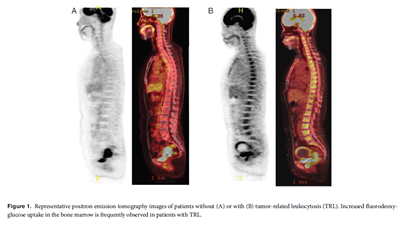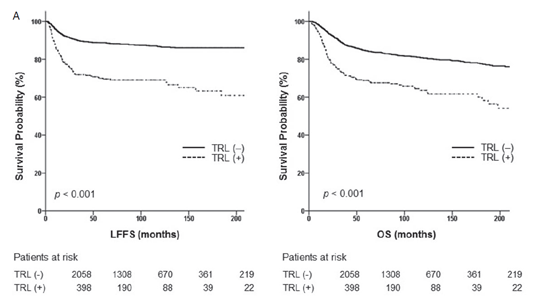글로벌 연구동향
방사선생물학
![[Ann Oncol.] Tumor-related leukocytosis is associated with poor radiation response and clinical outcome in uterine cervical cancer patients.](/enewspaper/upimages/admin_20161214140335_R.jpg) 2016년 12월호
2016년 12월호
[Ann Oncol.] Tumor-related leukocytosis is associated with poor radiation response and clinical outcome in uterine cervical cancer patients.연세의대/ 김용배*
- 출처
- Ann Oncol.
- 등재일
- 2016 Nov
- 저널이슈번호
- 27(11):2067-2074. Epub 2016 Aug 8.
- 내용

그림 1. 백혈구 증가증을 보이는 환자 중 종양성장인자분비로 인하여 PETCT에서 골수의 활성도가 증가한 예
그림 2. 백혈구 증가증(TRL) 유무에 따른 국소무진행생존율과 전체생존율의 차이Abstract
BACKGROUND:
To evaluate response to radiation and clinical outcome of uterine cervical cancer patients with tumor-related leukocytosis (TRL) at initial diagnosis and during definitive radiotherapy.
PATIENTS AND METHODS:
We retrospectively analyzed 2456 patients with stage IA-IVA uterine cervical cancer who received definitive radiotherapy with (37.4%) or without (62.6%) platinum-based chemotherapy between 1986 and 2012. TRL was defined as two or more occurrences of leukocytosis over 9000/μl at the time of diagnosis and during the course of treatment. Locoregional failure-free survival (LFFS) and overall survival (OS) were compared between patients with or without TRL.
RESULTS:
The median age of all patients was 55 years, and the median follow-up time was 65.1 months. TRL was observed in 398 patients (16%) at initial diagnosis; TRL (+) patients were younger and had larger tumors, advanced stage, and more frequent lymph node metastases (all P < 0.05). TRL (+) patients showed a significantly lower rate of complete remission than TRL (-) patients (89.9% versus 96.3%, respectively, P = 0.042). Ten-year LFFS and OS for all patients were 84% and 78%, respectively. LFFS and OS were significantly lower in TRL (+) patients than TRL (-) patients (10-year LFFS: 69% versus 87% respectively, P < 0.001; 10-year OS: 63% versus 81% respectively P < 0.001). After propensity score matching, LFFS and OS rates in TRL (+) patients remained significantly lower than for TRL (-) patients; this significant difference was also observed on multivariate analysis. Twenty-six percent of patients with locoregional failure (n = 345) were TRL (+) and had significantly poorer median OS (6 versus 12 months, P = 0.001).
CONCLUSION:
This study reveals the aggressive nature of cervical cancer with TRL and its poor response to radiation therapy. Given the unfavorable prognosis and higher probability of treatment failure, optimal diagnostic and therapeutic approaches and careful monitoring for early detection of recurrence should be considered for these patients.
Author information
Cho Y1, Kim KH1, Yoon HI1, Kim GE1, Kim YB2,3.
1Department of Radiation Oncology, Yonsei Cancer Center, Yonsei University College of Medicine, Seoul.
2Department of Radiation Oncology, Yonsei Cancer Center, Yonsei University College of Medicine, Seoul ybkim3@yuhs.ac.
3Yonsei Song-Dang Institute for Cancer Research, Yonsei University College of Medicine, Seoul, Republic of Korea.
- 키워드
- cervical cancer; leukocytosis; neutrophil/lymphocyte ratio; radiation response
- 연구소개
- 자궁경부암 환자에서 진단당시에 근치적 방사선치료 중 백혈구 증가증이 유지되는 환자들이 공격적인 진행경과를 보이는데 2014년 오사카 그룹이 Journal of National Cancer Institute에 종양이 종양성장인자를 분비하여 골수유래억제세포를 통해 면역회피현상을 유도한다는 것을 증명하였다. 이에 착안하여 본원에서 근치적 방사선치료받은 2456명의 기록을 리뷰하였음. 전체 환자 중 398명(16%)의 환자가 백혈구 증가증의 특징을 보였음. 백혈구 증가증군은 젊은 연령, 큰 종양 크기, 진행성 병기 및 빈번한 림프절 전이와 의미 있게 연관되었음. 또한 방사선치료 후 완전관해율이 유의하게 낮았으며 국소무진행생존율과 전체생존율이 의미있게 불량하였고, 이러한 경향은 propensity score matching후에도 유지되었다. 따라서 백혈구 증가증을 보이는 환자에 대해서 기존의 동시항암방사선요법이외의 새로운 치료적 접근이 필요함.
- 덧글달기
- 이전글 [Oncotarget.] Combined use of susceptibility weighted magnetic resonance imaging sequences and dynamic susceptibility contrast perfusion weighted imaging to improve the accuracy of the differential diagnosis of recurrence and radionecrosis in high-grade glioma patients.
- 다음글 [Biochem Biophys Res Commun.] APBB1 reinforces cancer stem cell and epithelial-to-mesenchymal transition by regulating the IGF1R signaling pathway in non-small-cell lung cancer cells.







